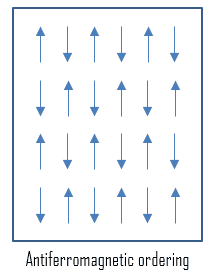Magnetic property refers to the response of a material to an applied magnetic field. The macroscopic magnetic properties of a material are a consequence of interactions between an external magnetic field and the magnetic dipole moments of the constituent atoms. Different materials react to the application of magnetic field differently. The most familiar effects occur in ferromagnetic materials, which are strongly attracted by magnetic fields and can be magnetized to become permanent magnets, producing magnetic fields themselves. Only a few substances are ferromagnetic. The most common ones are iron, cobalt and nickel and their alloys.
Antiferromagnetic Material – Antiferromagnetism
 In an antiferromagnet, unlike a ferromagnet, there is a tendency for the intrinsic magnetic moments of neighboring valence electrons to point in opposite directions. When all atoms are arranged in a substance so that each neighbor is anti-parallel, the substance is antiferromagnetic. Antiferromagnets have a zero net magnetic moment, meaning that no field is produced by them. Manganese oxide (MnO) is one material that displays this behavior. Generally, antiferromagnetic order may exist at sufficiently low temperatures, but vanishes at and above the Néel temperature. Above the Néel temperature, the material is typically paramagnetic, that is, the thermal energy becomes large enough to destroy the microscopic magnetic ordering within the material. The Néel temperature of MnO is about 116K.
In an antiferromagnet, unlike a ferromagnet, there is a tendency for the intrinsic magnetic moments of neighboring valence electrons to point in opposite directions. When all atoms are arranged in a substance so that each neighbor is anti-parallel, the substance is antiferromagnetic. Antiferromagnets have a zero net magnetic moment, meaning that no field is produced by them. Manganese oxide (MnO) is one material that displays this behavior. Generally, antiferromagnetic order may exist at sufficiently low temperatures, but vanishes at and above the Néel temperature. Above the Néel temperature, the material is typically paramagnetic, that is, the thermal energy becomes large enough to destroy the microscopic magnetic ordering within the material. The Néel temperature of MnO is about 116K.
We hope, this article, Antiferromagnetic Material – Antiferromagnetism, helps you. If so, give us a like in the sidebar. Main purpose of this website is to help the public to learn some interesting and important information about materials and their properties.